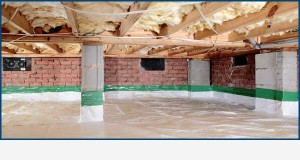I have been getting a lot of phone calls recently on the difference between crawlspace encapsulation and crawlspace ventilation. Which solution is better? Unfortunately, there is an abundance of information on the Internet about this topic. Some good, some bad, some extraordinarily bad. Since I am an expert in both solutions, I will try to emphasize some key points on both systems that you should consider before making a decision. Keep in mind that over the last 10 years there has been an explosion of manufacturer franchisee relationships that have popped up in the industry to push the encapsulation angle. The market is flooded with overpriced plastic, mold remediations, insulation products, and dehumidifiers. 
The most important decision that you could make is to hire an independent noncommissioned based professional in your area that is properly educated on crawlspace science and can explain the difference between the two systems properly. The consultant should have the ability to inspect the structure and advise a solution without manufacturer or dealer manipulation. There is no need to be overcharged for products and services that you don’t need.
A crawlspace encapsulation in a nutshell is a protocol where the contractor will close off all of the crawlspace vents, solve drainage problems, clean biofilm contaminants from the floor system, and install a fancy pool liner over the crawlspace soils including wrapping crawl space piers and often sealing the liner to the foundation wall of the crawlspace. A commercial dehumidifier must be installed to remove moisture build up from the air for this protocol to work properly or potential damage to the structure could occur. This system when installed properly does control crawlspace moisture problems, however, there are many disadvantages.
- Encapsulations are expensive
- Fiber reinforced liners are expensive
- Encapsulations eliminate fresh air exchange
- Dehumidifiers are expensive and need to be replaced often
- Dehumidifiers increase power consumption by $10-$50 dollars per month
- Encapsulations cause the air inside the crawlspace to become stale, which reciprocates to poor air quality inside the whole house envelope.
- Without fresh air introduced into the crawlspace, the soil, plastic, and other building materials off gas odors that clients can smell in the upper areas of the house.
- Termite inspections are impossible so many pest control companies cancel their termite bonds
- with their customers when they discover sealed crawlspaces.
- Sealed crawlspaces often require expensive HVAC upgrades to maintain safety and code requirements.
A dew point controlled crawlspace ventilation system is a solution that utilizes the existing crawlspace vents on the house to introduce outside air into the crawlspace envelop when it is drier outside. By utilizing the installation of a controller, interior and exterior sensors, strategic fan locations on the house, and a network of dead corner fans inside the crawlspace to service dead corners, the customer can solve their crawlspace moisture problem at a much more competitive price point than a sealed crawlspace. There are those whom will attack this solution because they have not educated themselves on how a dew point controlled ventilation system works. Keep in mind that older systems such as barometric controlled, temperature controlled, and humidistat control fans do not open and close at the right times to be effective, often making the problem much worse. In order for crawl space fans to work properly, they must be on a dew point controlled system.
The only fan system in the United States that possesses this technology is an Atmox controlled ventilation system. This smart system for your crawl space has been designed by engineers. If designed properly by an Atmox certified consultant in your area, your crawlspace vents can be engineered to work like they were supposed to work at the time of construction. The Atmox controlled ventilation system has several advantages:
- Solves crawlspace moisture problems with a warranty
- Fans use low voltage technology
- Contractor grade staked liners covering the surface soils of the crawlspace only are sufficient for the system to work.
- No need for dehumidifiers in most cases.
- No need for extra insulation.
- Allows fresh air into the space when it is drier outside.
- Improves air quality inside the whole house envelope.
- Keeps colder air from entering the space in the winter
- Keeps hotter air from entering the space summer.
- Prevents stale air from building up inside the crawlspace.
- Odors and smells from off gassing soil, plastic, and other construction materials is eliminated.
- Long-term maintenance costs are low.
- No expensive HVAC upgrades as and sealed crawlspace protocols
- Available for attics in Northern Climates.
There is certainly much more to learn about the science involved with both of these topics. For more information about crawl space moisture control please feel free to reach out to us with questions or concerns. I hope this short article has been helpful in getting you started on your quest for a real solution to you problem.
Need more specifics about your situation? Give me a call at (704) 787-6972 for your FREE phone consultation.
